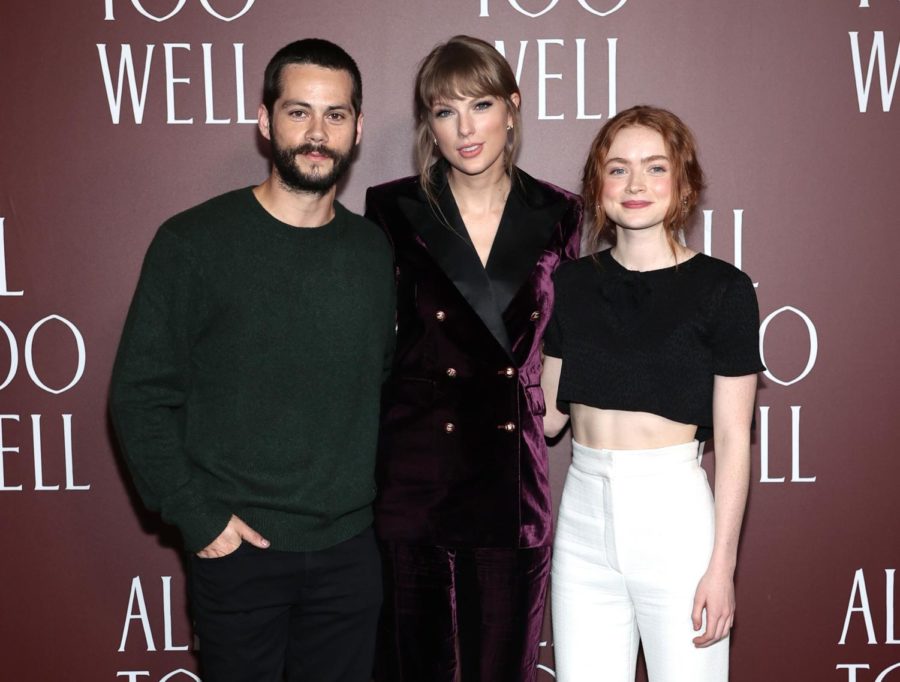“All Too Well” short film highlights Taylor Swift’s masterpiece of a song
Dylan O’Brien and Sadie Sink star in Taylor Swift’s “All Too Well” music video.
November 19, 2021
Without a doubt, Taylor Swift is the defining artist of the era. Even Billy Joel has dubbed her “the Beatles of her generation”—her influence permeates throughout almost every music genre and across social media. She even has a place in the world of academia, with her appearance on the 2021 AP United States Government and Politics exam (and honestly, I can only remember the year the Berlin Wall fell because it was the same year Taylor Swift was born).
While Swift is renowned for her music, her presence in the film industry has been growing in the past few years. Alongside all her incredible music videos and stadium tour films, Swift has had roles in “Hannah Montana: The Movie,” “Valentine’s Day,” “Cats” and “The Giver”. She has also starred in several documentaries, including “Miss Americana,” where she opened up about her personal struggles over the years, ranging from her reaction to media scrutiny to her mother’s cancer diagnosis. Lately, Swift has even started directing films of her own. Her first solo directorial piece was her 2020 music video “The Man,” which was later followed by music videos for “cardigan” and “willow,” along with the film “Folklore: The Long Pond Studio Sessions.”
Most recently, Swift released a 15-minute short film for her extended version of “All Too Well” alongside her new album, “Red (Taylor’s Version)”. “All Too Well,” a fan favorite from the original “Red,” was supposedly written about Swift’s breakup with ex-boyfriend Jake Gyllenhaal, who was 29 years old when he dated 20 year old Swift in late 2010; Swift has not concretely confirmed this.
Starring Dylan O’Brien as the love interest and Sadie Sink as young Swift, “All Too Well: the Short Film” takes the audience through a relationship in seven chapters: “An Upstate Escape,” “The First Crack in the Glass,” “Are You Real?”, “The Breaking Point,” “The Reeling,” “The Remembering” and “Thirteen Years Gone.” The film begins with the quote, “Love is so short, forgetting is so long,” and delves into the honeymoon phase of the relationship. With happiness and romantic excitement pouring through young Swift’s visit to her lover’s home—in which she leaves her scarf—and their trips upstate, audiences feel an air of positivity and trusting love. As the film continues and the relationship progresses—that initial starry-eyed happiness quickly fades in “The First Crack in the Glass,” as O’Brien’s character begins to neglect young Swift, treating her like a burden and gaslighting her, giving a glimpse of the pain to come. However, the anger and hurt of young Swift contrasts with “Are You Real?” as the characters dance in refrigerator light and spend intimate time together, showing the ups and downs of a relationship.
This mercuriality and instability comes to light as the lover lousily breaks up with young Swift in “The Breaking Point.” The ending of the relationship results in young Swift’s feelings of loneliness, brokenness and insecurity conveyed in “The Reeling,” as she staggers back from the sloppy, shoddy and sudden break up. This acute, initial pain ebbs into a dull, ever-present ache for both young Swift and her ex-lover, as a montage of effervescent and painful memories plays.
The film ends with Swift, playing herself, thirteen years later. In this reality she becomes an author, celebrating her novel “All Too Well” as her ex-lover looks on from outside of the store, wearing her red scarf. As he turns away with regret, he gives an answer to the lyric playing in the background, “Just between us, do you remember it all too well?”
Swift’s genius as an artist and director shines throughout every one of those 15 minutes, starting with the casting. Swift cast 19-year-old Sadie Sink—known for her role as teenage Max Mayfield in “Stranger Things”—as her younger self, and 30-year-old Dylan O’Brien—well regarded for his comical roles—as the love interest, in order to emphasize the age gap between Swift and Gyllenhaal (potentially). The innocence and naive hope Swift held when it came to that relationship, as well as how unexpected the manipulation in the relationship was, all shine through in the actors’ performances.
The brilliance of the film shines even more through its depiction of the polarity of the relationship, conveying how easily the happiest moments in a relationship can mask the most obvious red flags for those inexperienced in love. The one-sided nature of a toxic relationship also is shown, with young Swift emotionally investing everything into the relationship while her lover remains stoic and distant. Even more so, the devastation of young Swift in “The Reeling” and “The Remembering” segments wholly represents the universal sorrow felt after a breakup.
While the whole film is brilliant in acutely illustrating every aspect of a relationship doomed to fail, I found the ending, “Thirteen Years Past,” to be the most moving. The epilogue shows how much Swift has grown since that relationship, utilizing that pain for her own artistic success. “Thirteen Years Past” epitomizes why Swift is such an excellent role model—she has endured so many tribulations but still shines and inspires.
Taylor Swift, already a generational icon in so many people’s books, continues to grow her legacy as she re-records albums and expresses herself through new creative mediums, defying comments earlier in her career about her age and success. There are no signs of Swift’s artistic momentum stopping, with four more albums waiting to be re-recorded so she can own all of her back catalog. As we wait, I’ll be jamming to “Red (Taylor’s Version),” living “happy, free, confused and lonely at the same time.”


